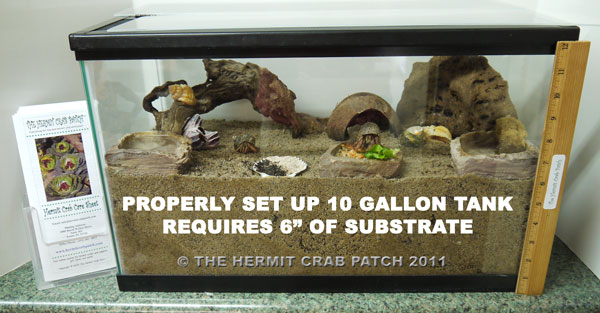Key To SurvivalPROPER SUBSTRATE TYPE, DEPTH AND MOISTURE CONTENTThe MAIN key to keeping land hermit crabs alive in captivity is to fill your crabitat uniformly with sand deep enough (3-4X their shell size) and moist enough (packs well) that your largest crab is able to bury into complete darkness to molt successfully.
In nature hermit crabs dig underground, when it is time to molt, for two reasons. First, they need the darkness that they get by burying in order for the molting hormone (ecdysone) to be secreted . This hormone is triggered by extended darkness and controls the actual shedding of their exoskeleton (ecdysis). Second, they need the isolation and protection that being buried underground provides them. A hermit crab that has just shed its exoskeleton is unable to move until it hardens up and regains muscle control. During this time they are vulnerable to cannibalism by other crabs and predators if they are not protected. The insulating properties of being buried underground provides protection from the elements and dehydration as well.
The best substrate for hermit crabs is what they would find in the wild typically a moist sandy / soil mixture. To simulate this we advise our customers to cover the entire bottom of their crabitat with a moist mix of clean course grade sand and moist coconut fiber. Coarse sand packs well and the moist coconut fiber helps with water retention. Large hermit crabs can stay buried under ground while they molt, for a period of up to 3 months, so the goal is to create deep moist substrate that will take very little care while they are buried. This way you will not have to disturb them while they are most vulnerable. 
Calcium type sand often sold in pet stores for hermit crabs is not suitable for use in a crabitat. It is very fine, powdery and easily sticks to a hermit crabs moist abdomen, not to mention it is typically very expensive. It is also designed to be used dry which does not allow hermit crabs to bury and successfully re-surface after they are done molting. One of the benefits touted for this substrate is that it clumps readily to wet waste material. As stated through out this section, your substrate needs to remain moist, making this sand unsuitable. Using moistened coconut fiber by itself in your crabitat is also poor choice as it provides molting crabs with very little protection increasing the chance of cannibalism. Using a mixture that is primarily sand (5 parts sand to 1 part coconut fiber) is much more protective. Remember, moisture is critical to enable hermit crabs to bury. You will want to maintain "sand-castle making consistency" of your substrate so that your crabs can dig and pack an underground cave and air space in which to molt. Dry sand will cave in on them as they try to bury. Add purified or even salt water to your substrate mixture as needed to maintain packing consistency. If crabs are buried, mist the surface well to prevent the substrate from drying out until they have resurfaced from molting. Then when you are certain that no crabs remain buried and molting, you can remove everything from the tank, add fresh water as needed to re-moisten and thoroughly re-mix your substrate to the perfect consistency so that it is ready for the next molting crab. SUBSTRATE DEPTH MINIMUM AND MOLT LENGTH DEPEND ON HERMIT CRAB SIZE
Additional Needs
|